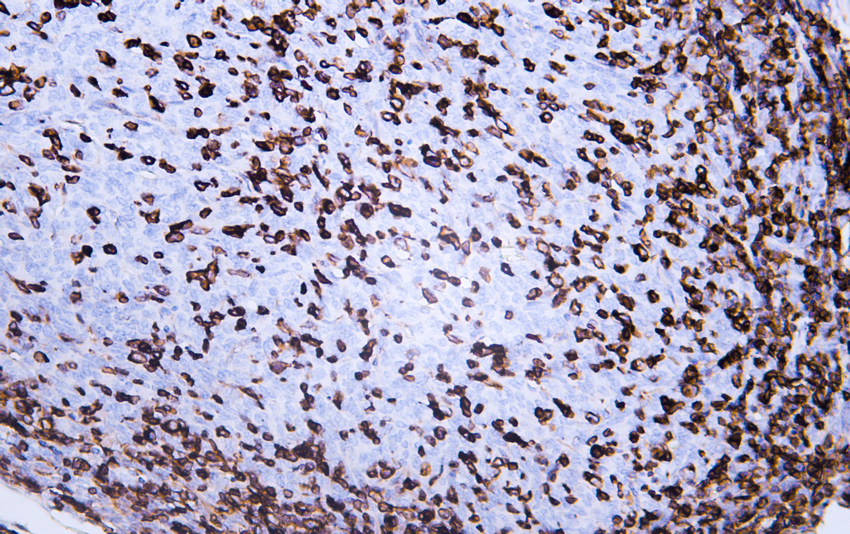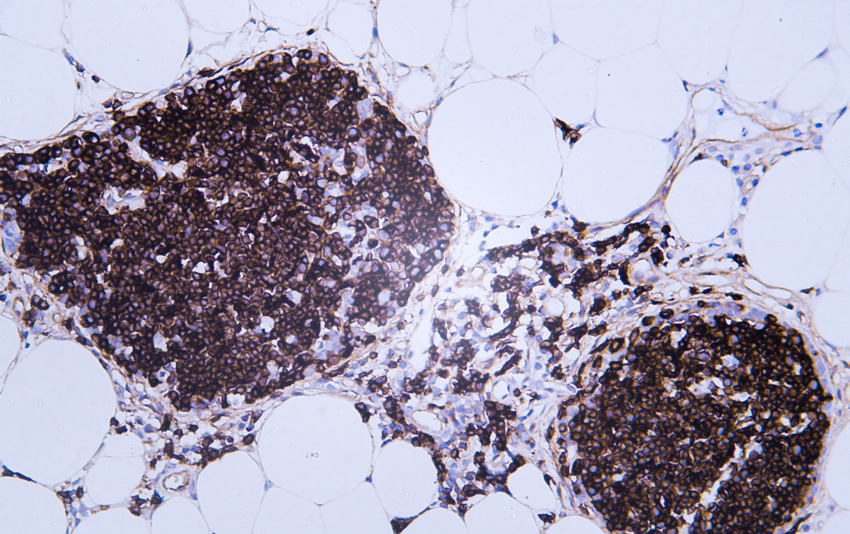CD99 (ABT156) IHC kit
- Catalog No.:IHCM6847
- Applications:IHC
- Reactivity:Human;
- Target:
- CD99
- Fields:
- >>Cell adhesion molecules;>>Leukocyte transendothelial migration
- Gene Name:
- CD99 MIC2 MIC2X MIC2Y
- Protein Name:
- CD99
- Human Gene Id:
- 4267
- Human Swiss Prot No:
- P14209
- Immunogen:
- Synthesized peptide derived from human CD99 AA range: 1-100
- Specificity:
- The antibody can specifically recognize human CD99 protein.
- Source:
- Mouse, Monoclonal/IgG1, kappa
- Purification:
- The antibody was affinity-purified from ascites by affinity-chromatography using specific immunogen.
- Storage Stability:
- 2°C to 8°C/1 year
- Other Name:
- CD99 antigen (12E7;E2 antigen;Protein MIC2;T-cell surface glycoprotein E2;CD antigen CD99)
- Background:
- The protein encoded by this gene is a cell surface glycoprotein involved in leukocyte migration, T-cell adhesion, ganglioside GM1 and transmembrane protein transport, and T-cell death by a caspase-independent pathway. In addition, the encoded protein may have the ability to rearrange the actin cytoskeleton and may also act as an oncosuppressor in osteosarcoma. This gene is found in the pseudoautosomal region of chromosomes X and Y and escapes X-chromosome inactivation. There is a related pseudogene located immediately adjacent to this locus. [provided by RefSeq, Mar 2016],
- Function:
- function:Involved in T-cell adhesion processes. It is involved in spontaneous rosette formation with erythrocytes.,miscellaneous:The gene encoding for this protein is located in the pseudoautosomal region 1 (PAR1) of X and Y chromosomes.,PTM:Extensively O-glycosylated.,similarity:Belongs to the CD99 family.,
- Subcellular Location:
- Membranous
- Expression:
- Membranous
- June 19-2018
- WESTERN IMMUNOBLOTTING PROTOCOL
- June 19-2018
- IMMUNOHISTOCHEMISTRY-PARAFFIN PROTOCOL
- June 19-2018
- IMMUNOFLUORESCENCE PROTOCOL
- September 08-2020
- FLOW-CYTOMEYRT-PROTOCOL
- May 20-2022
- Cell-Based ELISA│解您多样本WB检测之困扰
- July 13-2018
- CELL-BASED-ELISA-PROTOCOL-FOR-ACETYL-PROTEIN
- July 13-2018
- CELL-BASED-ELISA-PROTOCOL-FOR-PHOSPHO-PROTEIN
- July 13-2018
- Antibody-FAQs
- Products Images
.jpg)
- Human appendix tissue was stained with Anti-CD99 (ABT156) Antibody
.jpg)
- Human appendix tissue was stained with Anti-CD99 (ABT156) Antibody

- Human pancreas tissue was stained with Anti-CD99 (ABT156) Antibody

- Human thymoma tissue was stained with Anti-CD99 (ABT156) Antibody

- Human thymus tissue was stained with Anti-CD99 (ABT156) Antibody



